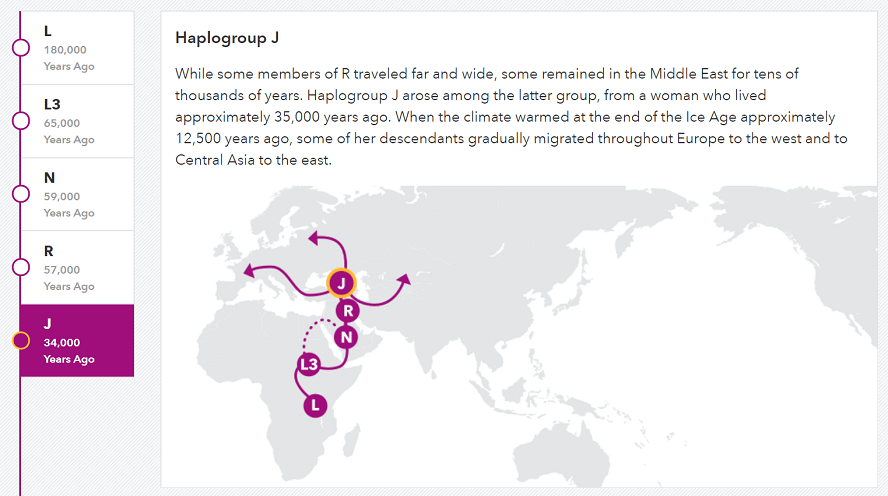
Male vs. Female DNA Testing – What are the Differences?
You may have heard that there are different DNA tests you can take – both for ancestry testing and You may have heard that there are different DNA tests you can take – both for ancestry testing and confirming family relationships – depending on whether you’re male or female. You may wonder whether the information you can find out about your family is limited by whether you were born male or female. This can sometimes be the case – though there are ways around it.
Some ancestry tests use male Y-DNA to trace paternal ancestry, and mitochondrial DNA (mtDNA) to trace maternal ancestry. While men and women both inherit mtDNA from their mother, only those born male inherit Y-DNA from their father. This means that while men can easily trace their maternal and paternal ancestry using their own DNA, those born female will need a male paternal relative to take a male haplogroup test on their behalf if they wish to learn about their paternal ancestry.
For many DNA tests the sex of the person being tested is irrelevant. This is because of the 23 pairs of chromosomes that make up our DNA, only one pair determines sex. The chromosomes that determine sex are X and Y. Those born genetically male have one X chromosome inherited from their mother, and one Y chromosome inherited from their father. Those bon female have two X chromosomes: one inherited from their mother, and one from their father.
Our remaining 22 chromosomes have nothing to do with determining sex, and are randomly inherited from both our mother and father. These contain the information that determine things like eye colour, skin colour, hair texture, and so on.
Autosomal DNA Testing
The majority of ancestry and health tests analyse only the autosomal DNA: the DNA contained in 22 of our 23 pairs of chromosomes, which men and women both have. These tests look for genetic markers at places in our genome where variations are known to occur. The genetic variants they look for are known as “SNPs”, or Single Nucleotide Polymorphisms. A SNP is a change of one allele or two alleles: the “letters” that make up our genome. These variations can tell us about our predispositions to certain traits and health conditions, and also serve as ancestry markers.
Ancestry tests such as AncestryDNA and MyHeritage look for variations in our autosomal DNA that can be used to trace the similarities in our unique genetics to global populations. These tests can show your ancestry up to around eight generations back. Unless you connect with a parent on an ancestry website such as 23andMe or AncestryDNA, it can be hard to tell which side of your family your ancestry is on using only autosomal DNA testing.
Some ancestry tests, such as 23andMe and Living DNA, look at both our autosomal DNA, and our mitochondrial DNA inherited from our mother, and the Y-DNA men inherit from their father, in order to trace our maternal and paternal ancestry as well as our autosomal (or “familial”) ancestry.
Tracing Maternal Ancestry
Men and women both inherit mitochondrial DNA (mtDNA) from their mother. Mitochondrial DNA doesn’t mutate often, and so it can be used to trace your maternal ancestry, tracking the migrations of your motherline way back in history.
Companies offering maternal ancestry testing include:
These companies will tell you which maternal haplogroup you belong to, as well as the larger haplogroups your subgroup split off from. Generally, you will be given a map showing the migrations of your maternal ancestors out of or within Africa, and some information about where members of your haplogroup commonly reside today.
The 23andMe maternal haplogroup map
Tracing Paternal Ancestry
Men, or those born biologically male, can easily trace their paternal ancestry through the Y-DNA contained in the Y chromosome inherited from their father. Like mitochondrial DNA, Y-DNA doesn’t mutate often, and so the rare mutations can be used to trace your paternal ancestry and haplogroup.
Companies offering paternal ancestry testing include:
You can get the same sort of information about your paternal haplogroup as for your maternal one: which paternal haplogroup you belong to, and which of the larger haplogroups your subgroup split off from. You will generally be given a map showing the migrations of your paternal ancestors out of or within Africa, and some information about where members of your haplogroup commonly reside today.
The 23andMe paternal haplogroup map
Women who want to trace their paternal ancestry will require a male relative on their father’s side to take the test for them.
Eligible relatives include:
- Your father
- Your brother (son of your father)
- Your paternal grandfather (father’s father)
- Your paternal uncle (father’s brother, son of his father)
- Your paternal cousin (son of your father’s brother, with the same paternal grandfather)
If you have no known male relatives on your father’s side, or are unsure which of your relatives are eligible to take a paternal ancestry test for you, then we have a guide for women who wish to trace their paternal ancestry here.
Confirming relationships with Y-DNA and mtDNA

It’s a bit old school, but DNA testing companies sometimes use mtDNA and Y-DNA to confirm familial relationships, instead of genetic markers found in autosomal DNA (which are most commonly used for relationship testing).
Mitochondrial DNA might be used to confirm relationships between siblings, or mothers and their children, or maternal aunts, uncles, and their nephews and nieces. Similarly, Y-DNA can be used to confirm relationships between fathers and sons, brothers, paternal uncles and nephews, and paternal grandfathers and grandsons.
Since not all close relations will share the same mtDNA or Y-DNA, these tests are quite limited, and not applicable to every situation, which is why testing of STRs (Short Tandem Repeats) is more commonly used for testing familial relationships.
Prenatal Sex Testing
There are many companies now offering prenatal sex testing. These tests analyse a sample of the mother’s blood, looking for cell-less DNA from the foetus. They don’t tell you anything about the foetus’ DNA other than the genetic sex, since what they are looking for is the presence of a Y chromosome in the mother’s blood. If a Y chromosome is found, it is supposed the foetus is male. If no Y chromosome is found, it is supposed the foetus is male.

Of course, quite a large sample of the mother’s blood must be tested in order to yield accurate results, and a professional will be needed to draw the sample. (Please bear in mind that any prenatal sex or paternity test that only requires a finger prick and does not require blood to be drawn by a professional will not yield an accurate result.)
Though many companies advertise that tests can be performed after ten weeks, there may not be enough foetal DNA in the mother’s bloodstream to be detected, which could potentially lead to a false result. A male baby may have a false female result if no Y-DNA is detected in the mother’s blood, while cross-contamination with male DNA could lead to a false male result for female babies.
If you choose to get a baby sex test, it is best to do so only in the spirit of curiosity, and not rely too heavily on the results. Additionally, this test should not replace an ultrasound test, or be considered more accurate.

eleanor
3 November 2019
I would like to find out the ancestry on my paternal side. My brother is the only surviving male. I have been considering this for a while now and don’t want to miss the opportunity as we are older. Which test should my brother and I take to get maximum information about our past. We come from a mixed marriage of Eastern and Northern European background.